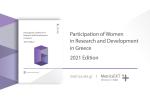
A continuous increase in the number of applications by enterprises wishing to receive tax benefits in terms of Research and Development (R&D) activities over the period 2010-2016, as well as the corresponding expenditure, is captured in a new study by the National Documentation Centre (EKT). The majority of applications came from small and medium-sized enterprises, while most of the R&D expenditure was attributed to large corporates.
Providing tax incentives in the form of providing tax benefits is considered to be an internationally effective mechanism for encouraging Research & Development in the private sector. The study focuses on the presentation of tax incentives available for businesses with activity in Greece, using data from the competent authority, the General Secretariat for Research and Technology (GSRT). Data analysed were broken down into two categories a) core corporate activity (manufacturing, services and other sectors) and b) size (large, medium and small businesses).
More specifically, the number of applications and the value of R&D expenditure (in millions of euros) of certified claims during 2010-2016 was tripled. In 2016, there were 96 applications, when back in in 2010 there were only 35. In addition, the R&D spending has been increased from €51.67 mil in 2010 to €158.24 mil in 2016.
An encouraging sign is that SMEs, which constitute the majority of Greek enterprise sector, increased their performance both in terms of the number of applications and the spending amounts that were requested.
Data analysis of applications and certified R&D expenditure by enterprise size and sector for 2010-2016 produced the following conclusions:
• The largest number of applications submitted by SMEs was above 70% during the whole period.
• The bulk of R&D certified expenditure was by large enterprises, while in the years 2015 and 2016, there was a big increase in the R&D expenditures of SMEs
• The average value of R&D expenditure per application remains almost constant during that period, amounting to about €6 million for large enterprises, to €0.6 million for medium-sized enterprises and €0.4 million for small businesses.
• The overall R&D expenditure by enterprises in the services sector, increased five times, from €12.95 mil in 2010 to nearly €70.93 mil in 2016. For the same period, R&D spending in the Manufacturing industry increased from €37.79 mil up to €83.64 mil euro.
• In manufacturing, the sectors with the majority of applications for R&D tax cuts were: ‘21-Production of basic pharmaceutical products and pharmaceutical preparations,’, "10-Food Industry’, ‘20-Production of chemicals and products ‘, ’25-Manufacture of metal products’ and ‘26-Manufacture of computer, electronic and optical products ‘, based on the NACE categorization.
• In the services sector, the majority of the applications came from the following industries: ‘62-Computer programming’, followed by ‘46-Wholesale trade’, ‘61-Telecommunications’, ‘72-Scientific research and development’ and ‘71-Architectural and engineering activities’.
• Throughout the period 2010-2016, only 157 enterprises submitted applications for R&D tax cuts under the tax laws 2238/1994 and 4172/2013. The total number of applications submitted to the GSRT was 350 for the seven year period.
Indicators for tax incentives basically are used for the cross-country comparisons of the current state of direct financial and tax support and policy implementation for R&D in the business sector. The National Documentation Centre (EKT) processes and reports data on R&D tax reliefs to the OECD in the relevant OECD database and related publications.
Research & Development tax breaks in EU and OECD
The current publication also discusses both European and global trends, along with the experience of other economies in this field. The majority of developed countries, particularly the OECD member countries and nearly all European Union economies, offer tax incentives for R&D expenditure. According to OECD data, for the year 2017, 30 countries provided tax incentives on R&D expenditure, nearly doubling since 2000 (16 countries).
Across countries, significant differences regarding the policy 'mix' to strengthen R&D activities in the business sector were recorded. For example, countries such as France, Belgium, the Netherlands, Australia, Ireland, Japan, Portugal, etc. seem to prefer tax incentives over direct state aid as the amount of provided tax incentives exceeds 80% of the total public funding for R&D in the business sector.
In contrast, some countries do not offer any tax incentives for enterprises to carry out R&D spending. This category includes countries such as Germany, Finland, Mexico, Luxembourg, Switzerland, Estonia, Cyprus and Bulgaria. Greece is among the countries where the applied policy mainly provides direct funding, with the figure in 2016 reaching 83.9% of total public funding.
Finally, the study includes in detail the B-Index, a particularly important indicator with a growing investment interest worldwide. The B-index is a measure for tax relief provisions, indicative for the generosity of the national tax system, used for calculating the 'implied’ marginal R&D tax subsidy rate per unit of investment in R&D activities. The lower the value of the B-Index (and correspondingly, the higher the ratio 1-B-Index), the higher the tax incentives for businesses and therefore the greater the incentive for investing in such activities (see OECD, 2013).
For Greece, the 1-B-Index shows an upward trend in the use of tax laws 4172/2013 and subsequent legislation. After 2016, the 1-B-Index stood at 0.11 for profitable enterprises and 0.08 for those making a loss. In Greece, no discrimination between large enterprises and SMEs is made when providing tax breaks, while those with a marginally more favourable status have profitable businesses.
Calculations were made using key tax rates and incentives that offer an insight into the highest levels of fiscal incentives. For more information about the calculations see https://www.oecd.org/sti/b-index.pdf, https://www.oecd.org/sti/rd-tax-stats-bindex-notes.pdf and http://www.oecd.org/sti/rd-tax-stats-2017cp-bindex-ts-notes.pdf.















